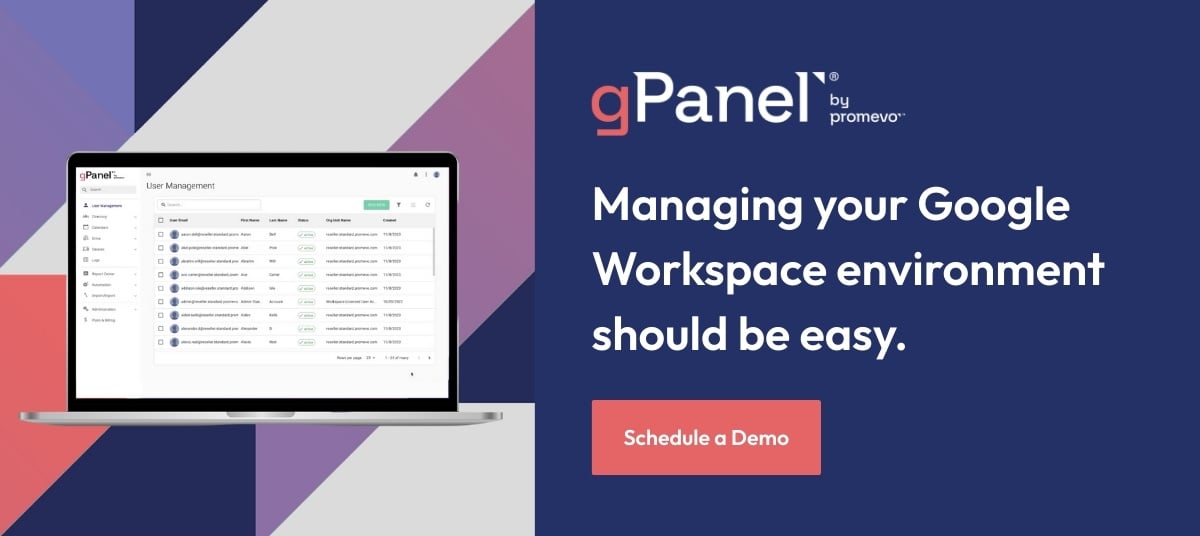In order to maintain the security of your organization's data, it's vital to have a strong password policy in place for all Google Workspace users. A password policy helps to reduce the risks associated with weak passwords and makes it harder for digital threats to infiltrate your system.
Let's explore why a password policy is important, how to configure one in Google Workspace, and some best practices for implementing a policy in your organization.
Why Is a Google Workspace Password Policy Important?
Google Workspace's password policy ensures data security for organizations using the platform. Implementing a strong password policy is essential to protect sensitive information and reduce the risk of unauthorized access or data breaches.
By setting up a Google Workspace password policy, you can establish minimum password requirements, password length, complexity settings, password expiration, and recovery options for your users.
This comprehensive approach to password management ensures that your organization's email accounts, documents, and data remain secure.
In addition, adhering to the Google password policy further strengthens overall data security. A strong password policy can prevent cyber criminals from guessing, phishing, or brute-forcing their way into your Google account, which could lead to the loss of proprietary information, financial data, or even access to your entire business account.
So, implementing a well-defined Google Workspace password policy is fundamental for your organization's data management and security strategy.
Configuring Google Workspace Password Policy
To enhance the security of user accounts and meet compliance needs, Google Workspace provides administrators with options to configure the password policy.
This policy includes requirements for password length and complexity, password expiration, and password recovery options. Here's an overview of each aspect.
Length & Complexity Requirements
Workspace allows Google administrators to enforce strong passwords by specifying length and complexity requirements. Passwords can be set to require a certain number of characters, including uppercase letters, lowercase letters, numerals, and special characters.
The password strength-rating algorithm ensures that passwords have a high level of randomness and are not commonly used weak passwords or easily guessable phrases. It also checks if the password is compromised.
Password Expiration & History Settings
While password expiration is turned off by default, administrators have the option to set passwords to expire after a specific number of days for compliance reasons. Expiring passwords is no longer recommended in modern security theory.
Additionally, Google Workspace provides password alerts to users through pop-up notifications when their passwords are about to expire, helping them stay informed about password changes.
Password Recovery Options
In terms of password recovery, Google Workspace offers various options to users.
When users forget their passwords, they can use the account recovery process, which typically involves providing an alternate email address or a phone number associated with the account.
Administrators can also customize password recovery options for organizational units and provide additional security measures, such as multi-factor authentication, to ensure secure account recovery.
Best Practices for Google Workspace Password Policy
By following best practices for passwords in Google Workspace, organizations can enhance their password policies and protect sensitive information from unauthorized access. Here are the key areas to consider.
Educating Users on Password Security
Educating users about password security is the first step in promoting strong password practices. Organizations should provide clear guidelines on creating strong passwords and the importance of protecting their accounts. Some recommended practices include:
- Requiring strong passwords: Administrators can enforce password requirements such as a minimum length, a combination of uppercase and lowercase letters, numbers, and special characters.
- Preventing password reuse: Users should be discouraged from reusing old passwords to minimize the risk of compromise.
- Password strength tips: Sharing password tips and best practices with users can help them create strong and unique passwords.
Enabling Multi-Factor Authentication
Multi-factor authentication (MFA) adds an extra layer of security by requiring users to provide additional verification, such as a code generated on a mobile device, in addition to their password.
Enabling MFA for Google Workspace accounts significantly reduces the risk of unauthorized access, even if passwords are compromised. Administrators should encourage users to enable and use MFA to enhance security.
Regularly Auditing & Updating Policies
To maintain strong security practices, it is important to regularly audit and update password policies. This includes:
- Monitoring password strength: Administrators can use Google Workspace tools to assess the strength of users' passwords and identify weak passwords that need to be changed.
- Periodic password expiration: While password expiration is not always necessary, some compliance requirements may necessitate setting a password expiration period.
- Regular policy review: Administrators should review and update password policies based on emerging threats and best practices to ensure ongoing effectiveness.
Continual Improvement & Adaptation
Maintaining a strong password policy requires continuous improvement and adaptation to evolving threats. Organizations should:
- Stay informed about security best practices: Administrators should regularly follow security resources and stay up to date with the latest recommendations for password policies.
- Conduct security awareness training: Regularly train users on password security, phishing awareness, and other cybersecurity topics to reinforce good practices and mitigate risks.
- Monitor security breaches: Stay vigilant for any reports of compromised accounts or data breaches and take immediate action to protect affected users.
- Leverage Google Workspace updates: Keep an eye on updates and new features released by Google Workspace to take advantage of enhanced security options and improvements in password policy management.
By implementing these best practices and staying proactive, organizations can significantly improve the security of their Google Workspace accounts and protect valuable data from unauthorized access.
Strengthen Your Password Strategy With gPanel
A well-crafted password policy is one of the simplest yet most powerful defenses against cyber threats in your Google Workspace environment. From enforcing strong password requirements to enabling multi-factor authentication and regular policy audits, taking proactive steps today can prevent costly incidents tomorrow.
But managing and enforcing these best practices at scale, especially in a growing organization, can be time-consuming and complex.
That’s where gPanel comes in.
With powerful features like automated password resets, delegated user access, policy enforcement, and centralized control over account security, gPanel streamlines Google Workspace administration so your team can stay focused on what matters most—without compromising security.
Ready to see how gPanel can simplify your Google Workspace management and elevate your password policy. Schedule a demo to see the platform in action and discover how it can help your organization stay secure, efficient, and compliant.
FAQs: Google Workspace Password Policy
How do I set up a password policy in Google Workspace?
To set up a password policy in Google Workspace, you can follow these steps:
1. Sign in to your Google Workspace admin console using your administrator account.
2. Go to the "Security" section of the admin console.
3. Click on "Password strength" to enforce password policy requirements for your users' managed Google Accounts.
4. In the password strength settings, you can configure the following options:
- Require a strong password: Enable this option to force users with weak passwords to change them. You can also specify a certain number of characters for passwords.
- Prevent users from reusing old passwords: Enable this option to disallow users from using their previous passwords.
- Explain the importance of strong passwords: You can share password tips with users to help them create strong passwords.
5. Save the changes to apply the password policy.
What is the minimum password length in Google Workspace?
The default minimum password length in Google Workspace is configurable from 6 to 30 characters with a default minimum of 6 characters. However, administrators can adjust the minimum password length requirement using the Admin Console. It's generally recommended to use a minimum password length of at least 12 characters for enhanced security.
How often should users change their Google Workspace passwords?
The exact frequency of password changes may vary depending on your organization's specific needs and risk tolerance. However, many experts recommend updating passwords every 60 to 90 days. Administrators can enforce password expiration policies using the Admin Console to require users to update their passwords periodically.
Meet the Author
gPanel by Promevo
gPanel is Promevo's exclusive Google Workspace management and reporting solution. Our software provides organizations and their Google administrators with all the tools they need to manage users effectively in their domain while safeguarding sensitive data.

Building an IT Incident Response Plan for Google Workspace (Before You Need It)
No Google Workspace administrator ever hopes for an emergency, but incidents happen — breaches, outages, insider errors, or ransomware. The only...

Using the Google Workspace Control Panel
In order to make the most of the Google Workspace platform, it’s essential to have a strong understanding of the Google Workspace Control Panel, also...








